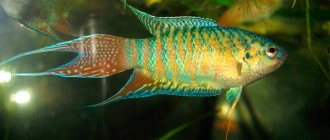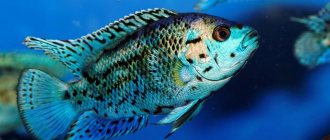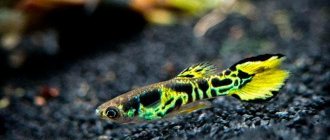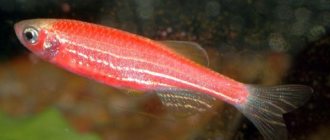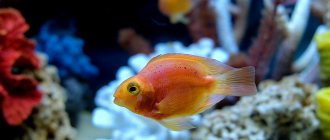The Neon aquarium fish has been known for a long time, but its popularity is still at its peak these days. The mesmerizing flock is an indescribable spectacle. Few can compare with the beauty of Neons, and the friendliness of underwater inhabitants and their ability to easily adapt to their environment make the fish ideal pets.
But still, to maintain them you need to know some nuances. In this article we will describe what is needed for maintenance, what to feed, and what is needed for reproduction.
Aquarium fish Neons photo and description
A miniature fish about 4 cm in size. They live for about 3-4 years. A distinctive feature is a bright luminous stripe on the sides of most types of Neon; it is visible along the entire body. The different subspecies are distinguished by all sorts of color variations of this stripe, supplemented by some color details.
Very active fish that prefer to stay in a school. By creating harmonious living conditions, you can achieve the most vibrant colors and enjoy the magnificent view of these underwater inhabitants.
Content Rules
If you want to get fish for the first time, the ideal option is neon fish. Maintaining and caring for them is not particularly difficult even for a novice aquarist. They are usually bred in large quantities for sale.
Despite their miniature and fragility, aquarium fish neons are quite hardy and adapt well to new conditions. But a sudden change in habitat is a difficult test for them. Therefore, they need to be placed in a prepared aquarium with settled water and an established ecosystem. In favorable conditions, blue neon can live 3–4 years.
Aquarium fish Neons maintenance and care
As mentioned earlier, the fish are very unpretentious, but Neons can only be introduced into a well-established aquarium, in which fluctuations are minimized. The optimal water indicators are 7 pH, and the hardness is not higher than 10° dH.
An important point in keeping is to have a place in the aquarium where you can hide. Abundant thickets of algae and floating plants, which can create shelter on the surface of the water, are suitable for these purposes.
A sense of security is a necessary condition for the comfort of fish.
There are no special requirements for the soil. From an aesthetic point of view, it is recommended to choose a dark-colored primer. According to experts, with it the aquarium in which Neons live will look as impressive as possible.
In principle, maintenance is quite simple and does not require much effort on the part of the owner. It is important to maintain the temperature at +22-26° C. For purification, various filtration systems are used and a quarter of the water is replaced weekly.
To achieve the most aesthetic appearance of an aquarium with Neons, it is worth planting it densely with plants, for example, various types of sagittaria, Vallisneria nana, Vindelova fern and many others. You can add decorative elements.
What to feed Neon fish
For picky fish, you can use daphnia and dry gammarus as food.
Live food is most often used as an additional treat. Diet variety will help maintain health, stimulate growth, and achieve bright neon colors.
It is important not only to feed the fish, it is also important to feed them correctly. Optimally – 1-2 times a day. The main cause of many diseases, and even death, is overfeeding. After feeding, any remaining food must be removed.
In addition, when choosing a neighborhood for your pets, you should pay attention to the similarity of their gastronomic needs.
Diet: bloodworms, cyclops, daphnia, enchytraea, gammarus. Industrial feed is acceptable.
Neon's anatomical feature is a small mouth, so it is important to select medium-sized food that the fish can swallow.
Table of basic parameters of maintenance, care and nutrition:
| What should be the volume of an aquarium for Neon? | from 10 liters for a pair of Neons for a flock from 50 liters (also depends on the type) |
| What should be the temperature in the aquarium for Neon? | from +20-31° C |
| What pH should be in the aquarium? | from 5-8 pH |
| What should be the hardness of the water in the aquarium? | up to 15° dH |
| What should be the substrate for an aquarium? | any |
| What kind of lighting should be in the aquarium? | 0.5-0.8 Watt/l daylight for at least 12 hours |
| What should be the movement of water in the aquarium? | moderate |
| Maximum size of Neon | up to 5 cm |
| What does aquarium fish eat? | dry food, daphnia, tubifex, bloodworms |
| Type of aquarium fish | non-aggressive |
| Who is compatible with in an aquarium? | get along with small non-aggressive fish species and shrimp; |
| Lifespan | from 3-5 years |
For most types of Neons, the rule is: 1 liter of aquarium per 1 individual. For example, in a 10 liter aquarium you can add 10 Neons. But for a comfortable, painless life, it is better to house 6-7 individuals.
Feeding Neons
High-quality dry food is excellent for feeding neons at home. It is not recommended to use frozen and live ones, because they do not contain the full range of nutrients and can easily become a source of infection in the aquarium.
Neons are fish with a small mouth, which must be taken into account when choosing food. You can opt for the following foods:
- Tetra Micro Crisps is food in the form of chips for small ornamental fish. Fully balanced, contains natural color enhancers and herbal ingredients to maintain the health and vitality of your fish. The small chips soften quickly, making them easy for Neons to eat.
- TetraPro Energy is a highly nutritious food in the form of chips, manufactured using a special low-temperature technology, which allows you to retain even more nutrients. The center of the chips contains an energy concentrate to keep your neons always active.
- TetraMin Mini Granules are a basic food for all types of small tropical fish. The pellets sink slowly, making it easy for fish to collect them. Made from a mixture of more than 40 components of high quality raw materials. Contains prebiotics for the proper functioning of the fish's gastrointestinal tract, and the special BioActive formula supports a healthy immune system.
It is best to feed Neons 2-3 times a day with a small portion of food, which will be completely eaten in a couple of minutes. You should not overfeed your pets, they are prone to obesity.
Neons types with names and descriptions
Small fish that shimmer in different colors have been considered the most popular among aquarists for many years. All possible color options will not leave anyone indifferent.
Neon red
The female Neon red reaches 4.5-5 cm in length, the males 2.5-3 cm. The red stripe is more saturated in color, it is somewhat wider than that of the ordinary Neon.
It is customary to keep peaceful fish in small groups and avoid the company of predatory fish. Life expectancy is 3-5 years in an aquarium. Temperature from +23-26 ° C, acidity from 6-7 pH, hardness up to 5 ° dH. 6 individuals require an aquarium of 60 liters.
Neon green
Neon is green; the greenish tint of the back is combined with a white belly. The fins are colorless. The length rarely exceeds 4-4.5 cm. For a pair of green Neons you need an aquarium of 15-20 liters.
It is acceptable to keep such a pet in a small aquarium in the vicinity of other species. The peaceful fish is very mobile and can jump out of the water, so you should take care of its safety and cover the aquarium with a lid. Temperature from +22-26° C, acidity from 5-6 pH, hardness from 2-8° dH. With proper maintenance, life expectancy is up to 5 years.
Neon blue
Neon blue also has a name - ordinary. This Neon has a slender body with a shining blue stripe on the sides. Almost transparent fins add contrast to the expressive body. Grows up to 4 centimeters. A flock of 10 blue Neons requires an aquarium of at least 50 liters.
Perhaps this is the most popular fish, which is very often kept by aquarium lovers. It is unpretentious, which makes it an ideal option for beginners. Temperature from +20-25° C, acidity from 5-7 pH, hardness from 1-10° dH. With proper maintenance, life expectancy is up to 5 years.
Neon black
The main distinguishing feature of Black Neon is its color. A luminous golden-green stripe is visible along the sides, the color of the back is approaching brown. The presence of an additional black stripe was the reason for giving the fish this name. Black Neon grows up to 4 cm. For a flock of 10 black Neons, you need an aquarium of 60 liters.
The conditions in the aquarium should be: temperature from +20-25° C, acidity from 6-8 pH, hardness from 5.5-15° dH. When maintained in all conditions, life expectancy is from 3 to 5 years.
Neon blue
Blue Neon, like other types of Neons, prefer to stay in flocks and not conflict with other inhabitants of the aquarium. The size of a female Neon is up to 3.5 cm, and a male is from 1.5-2 cm. For a flock of 15 blue Neons, you need an aquarium of 50 liters or more.
The conditions in the aquarium should be: temperature from +22-26° C, acidity from 5-6 pH, hardness from 1-4° dH. When maintained under all conditions, life expectancy is up to 5 years.
Neon gold
A representative of this species is essentially another variation. From the name you can guess that the body has a golden color. The usual stripe running along the entire body is combined with a turquoise frame of the eyes. Golden Neon can create a very impressive look for the underwater kingdom, especially if kept in a school. The optimal number of individuals is 7-9 pieces. The maximum size of golden neon is up to 1.5 cm. A flock of 6 individuals requires an aquarium of 15 liters.
The temperature in the aquarium should be from +22-26° C. The acidity of the water is from 5.8-7.5 pH. Water hardness up to 15° dH. Lives in an aquarium for up to 4 years.
Neon savannah
Perhaps the Savannah Neon is the hardiest type of Neon. An ideal candidate for a community aquarium. The place of natural habitat in the wild was the reason to give the fish this name.
They can grow up to a maximum of 2-3 cm. They are painted gray, the usual stripe glows.
Despite their unpretentiousness and high adaptability, they are sensitive to water quality. It is important to control its parameters and try to create optimal and comfortable conditions for the fish. Temperature from +20-25° C, acidity from 5.5-7.5 pH, hardness from 1-12° dH. A flock of 10 or more individuals needs an aquarium of 50 liters or more.
If these requirements are met, reproduction is possible all year round. It is necessary to plant a couple so that they do not eat the eggs.
Neon diamond or diamond
Diamond or diamond neon was created artificially. The head is blue. The red stripe extends to the tail. The main color of diamond neon is silver, with a bluish tint. Perhaps these are the only representatives of Neons that are distinguished by the fact that they are territorial. For 6 individuals you need an aquarium of 15-20 liters.
Maximum length up to 3-3.5 cm. Temperature for maintenance should be from +23-27° C. Acidity from 6-7 pH. The water hardness in the aquarium should be between 3-12° dH. Life expectancy is up to 3-4 years.
Neon lilac Kerry
The body length of Lilac Neon reaches a maximum of 3.5 cm. They are distinguished by a peaceful disposition and are very unpretentious in care. They are easily bred, without requiring extremely difficult conditions for this.
The lilac color dominates the coloring with a hint of purple, and a dark stripe stretches along the body. Bright males look most impressive; females usually appear in more subdued colors. Their colors are predominantly brown and yellow. A flock of 10 Kerry nens needs an aquarium of at least 50 liters.
For maintenance, a temperature of +24-27° C is required. Acidity is from 5.5-7 pH. The water hardness in the aquarium should be between 1-12° dH. Under these conditions, Neon Kerry lives from 3-5 years.
Neon Erythrozonus
Neon Erythrozonus is a small aquarium fish up to 4 cm in size, attracted by the presence of a bright orange neon stripe. What makes it unique is the base color, which is almost completely transparent. With age, the color becomes more pronounced, and the fish takes on an even more attractive appearance. A flock of 6-7 Neons Erythrosonus needs an aquarium of at least 60 liters.
The water temperature in the aquarium is from +22-26° C. The acidity in the aquarium is from 6.5-7.5 pH. Hardness in the aquarium is from 4-12° dH. Under these conditions, Neon Erythrozonus lives up to 5 years.
Neon blue eyes
The aquarium pet is very common. Quite unpretentious, they produce offspring in captivity. They live in an aquarium in a flock of 8 individuals in an aquarium of 40 liters and at a temperature of +21-31° C, acidity of 7-8 pH, and water hardness of 10-26° dH. In brackish water, the blue-eyed neon lives much longer and feels more energetic.
The maximum body size usually does not exceed 3-4 cm. The color is yellow and blue, the back has a neon sheen. Females have a calmer color option. If in almost all species of Neons the females are larger, then in the blue-eyed Neon the opposite is true - the males are larger with a brighter color.
Neon tricolor (Heterorabdus)
Neon tricolor grows up to 4.5 cm. Its characteristic color is a black-golden-red stripe and a silver belly. Because of the longitudinal stripe consisting of three colors along the body, the fish got its name. In some literature you can find the name - the Belgian flag.
Tricolor Neon is a schooling fish that is comfortable in a school of 6 or more individuals and in an aquarium of 60 liters or more. With temperatures from +23-26° C, acidity up to 6.5 pH and water hardness from 3-4° dH.
Neon platinum
Platinum neon has a second name - gold Tetras. Scales with a golden tint highlight aquatic inhabitants. Guanine, located under the skin, not only provides it with a unique color, but also protects it from parasitic organisms that could cause harm to health.
In captivity, Platinum Neon reaches up to 4.5 cm. A couple of platinum fish can be kept in an aquarium of 10 liters or more, but Neons are schooling fish. The flock should consist of 10-20 individuals and the aquarium should be at least 100 liters. The temperature in the aquarium is from +24-28° C, the acidity is from 6-7 pH and the water hardness is from 2-12° dH.
They retain the ability to reproduce, but it is almost impossible to preserve their unique natural color. Under artificial conditions, the fish becomes silver.
Neon Peruvian (Hifessobricon Loreto)
Peruvian neons reproduce without difficulty in captivity. They do not require special conditions and get along with a wide variety of non-aggressive underwater inhabitants. Grows from 3-4 cm.
The body is grayish-silver. The longitudinal stripe has a dark color, which is complemented by a unique golden-neon touch.
For 10 individuals you need an aquarium of 60 liters. The temperature in the aquarium should be +22-27° C, acidity from 5-7 pH and water hardness from 2-10° dH. Life expectancy is up to 2-3 years.
Neon Boelka, Blue Tetra, Belkea (Boehlkea fredcochui)
This type of Neon is called differently: Boelka, Boelka bluish, Blue tetra, Belkea (Boehlkea fredcochui). Appearance is characterized by a silver body with a magnificent neon tint close to blue. Despite the maximum size of 5 cm, it is quite difficult to keep such Neons in a home aquarium.
To keep a pair of Neons you need an aquarium of 15-20 liters. For a flock of 10 individuals, you need an aquarium of 80 liters and a temperature of +22-27 ° C, acidity from 5-7 pH and water hardness up to 15 ° dH. Life expectancy is up to 2-3 years.
Neon voile
Neon veil is a rare specimen that was bred artificially; this species does not exist in nature. Due to the long veil, decorations in the aquarium need to be minimized.
The size of the female reaches up to 4 cm, the male is 0.5-1 cm smaller. To keep 4 veil Neons you need an aquarium of at least 10 liters. Temperature +23-24° C, acidity from 6.5-7 pH and water hardness from 5-7° dH. Life expectancy is up to 3-5 years.
Neons aquarium fish which fish get along with
Neons are classified as very calm, peaceful inhabitants. Conflicts are not typical for them; they get along well in common aquariums with other peaceful fish.
Predators are a bad company for Neons, because they can simply eat them. Such a proximity provokes stress for the fish, and this, as is known, affects the intensity of color, can reduce immunity and lead to many diseases.
Predators include: Angelfish, Barbs, Cichlids, Maingano, Gourami, Labeo, large catfish, Goldfish and others.
Ideal neighbors are various colorful fish: Guppies, Cardinals, Swordtails, Danios, shrimp, Tetras, Norman's blue-eye and many other peaceful aquarium fish of similar size.
Neon compatibility
Neons are one of the best candidates for keeping in community aquariums. These peaceful and calm characins get along well with a large number of species of small ornamental fish.
As suitable neighbors, we can recommend popular viviparous fish (from guppies to swordtails), cardinals, rasboras, tetras, and nanostomuses. They get along well with apistogramma, shrimp, gouramis, and lalius. You can be added to other types of neon without fear. Peaceful catfish - ancistrus, corydoras - will also not conflict with neons.
But combining neons with predatory and territorial fish is strictly contraindicated. Their shiny stripe is very attractive to large fish species. Therefore, sooner or later, neons will find themselves in the mouth of such a “neighbor.” The general rule when choosing roommates is that neon should not be placed in the mouth of another fish.
Neons do not bite off or dig up living plants, so any suitable species of aquatic vegetation can be planted in an aquarium with them.
Other interesting articles
- Varieties of aquarium fish The number of varieties of aquarium fish is in the thousands, and each of them has its own characteristics. Agile and...
- What fish can live without aeration, air in the aquarium? What fish can survive without oxygen and filtration? No living creature can live without...
- How to properly feed fish in an aquarium with frozen food. How to properly feed fish with frozen food? Before answering this question, you need to know that...
Aquarium fish Neons reproduction
The period of sexual maturity depends on the species, but usually from 5-8 months. Under optimal conditions, the ability to reproduce remains up to 4-5 years.
A minimal amount of light is required, because caviar is very sensitive to it. In the first days after spawning, it is recommended to remove the aquarium in a dark place. It is important to maintain water temperature, hardness, and acidity in accordance with the requirements of a particular type of Neon.
Also, for laying eggs you need plants, suitable: various types of mosses, various types of sagittaria, vindel fern and many others. Or you can use a nylon sponge instead of plants; the female can lay eggs on it. To avoid eating the eggs, the parents should be separated.
Incubation lasts 4-5 days, and after another 3 days the fry will swim. The ideal diet for him is ciliates and egg yolk. Considering the small size of the fry, it is worth staying away from the filters to prevent the fish from dying in them.
You should not allow the presence of a film on the surface of the water, this can have a detrimental effect on the fish. The reason for its appearance is often the lack of aeration, which promotes the development of bacteria. To remove the film, you can use a sheet of paper of the appropriate size. The film sticks to it perfectly.
How to properly keep neon fish in an aquarium
So, neons are indeed very picky creatures in all respects, and we will see this right now. But, like any living creature, even these unpretentious beauties have their own specific habits and needs, the observance of which directly determines the quality and duration of their life.
By the way, about life expectancy. These fish can live up to 4-5 years in an aquarium. And here, to a greater extent, everything depends on the conditions of their detention.
One of the truly important parameters of their maintenance should be considered compliance with the correct temperature regime. This is the range of 18-24 degrees, and, if possible, the slope should be closer to 22 degrees. This is the ideal temperature indicator for neon.
As the temperature inside the tank increases, the biorhythm of life of these fish increases in direct proportion. Thus, at 26 degrees, your neons are unlikely to live beyond two years. And this point should be taken into account first of all.
With regard to other characteristics of water, such as hardness and acidity, it should be said that neons do not have increased requirements for them.
Neon diseases and their treatment
Like all living things, aquarium inhabitants can be attacked by pathogens and become infected with parasitic worms or crustaceans. Contagious and non-contagious diseases are quite widespread and can lead to massive fish deaths. As for Neons, in the right conditions and with good care, they are resistant to disease.
Illness is an emergency for the aquarist. It is important to understand that the most effective remedy against outbreaks of fish diseases is their prevention. With poor care and constant stress, the fish’s immunity decreases, and as a result, it gets sick.
The most common disease of Neons is Neon disease (Plistiphorosis), which is infectious in nature and classified as incurable. At the first signs of the disease, the luminous stripe disappears, and then the entire color fades. The fish become separated from the school, lose their appetite, and acquire an abnormal position while swimming. The fins are gradually destroyed. Unfortunately, there is no treatment.
If this type of disease is detected in an aquarium, then all fish living in it must be eliminated, and the soil and all accessories must be disinfected to destroy the spores. Fish that still look healthy are carriers of the pathogen and therefore must also be destroyed.
It is worth differentiating plistyfiroz and false neon disease. The symptoms are very similar, but the disease is caused by a different pathogen and can be treated. To determine an accurate diagnosis, laboratory diagnostic methods will be required. Quarantine is required.
Saprolegniosis is another disease to which rheons are susceptible. It is of fungal origin and occurs when maintenance conditions are not met. The clinical manifestation is pronounced - the body of the fish is covered with a white spore-like coating, the fins stick together.
Although the appearance of the fish and its condition are greatly affected, the disease is quite easy to treat. A quarantine is required, which requires daily baths using malachite green, table salt or methylene blue and a slight increase in water temperature + 25-26 ° C. These simple manipulations will help cope with the disease within a week.
Diagnosis and treatment can cause some difficulties, especially for an untrained aquarist, so it is better to contact ichthyopathological laboratories.

